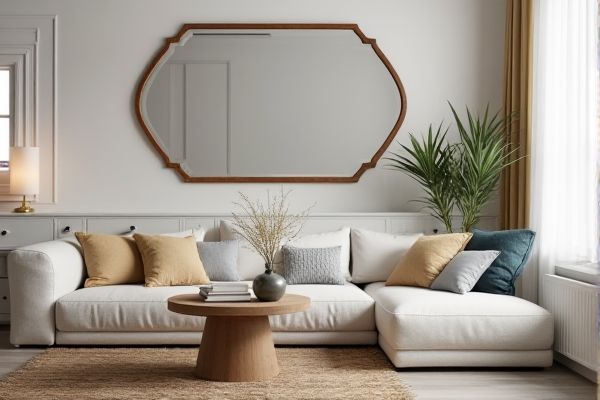
Decorative mirrors enhance your space by adding style, texture, and visual interest, while functional mirrors prioritize practicality for daily tasks like grooming and dressing. Explore the article to understand how to choose the perfect mirror that balances aesthetics and functionality for your home.
Table of Comparison
| Feature | Decorative Mirror | Functional Mirror |
|---|---|---|
| Primary Purpose | Enhance aesthetics and interior style | Assist in grooming and personal care |
| Design | Ornate frames, artistic shapes | Simple, clear reflection surface |
| Placement | Living rooms, hallways, bedrooms | Bathrooms, dressing rooms, entryways |
| Size | Varies widely, often large for visual impact | Typically medium to small for close viewing |
| Functionality | Focus on form over function | Focus on usability and clarity |
| Lighting | May include decorative lighting | Often integrated with task lighting |
| Cost | Varies with design complexity | Generally affordable and practical |
Understanding Decorative Mirrors
Decorative mirrors enhance your interior design by acting as artistic focal points, often featuring intricate frames and unique shapes that complement your decor style. Unlike functional mirrors primarily intended for reflection and utility, decorative mirrors prioritize aesthetics and spatial ambiance, adding depth and light to rooms. Choosing the right decorative mirror helps you express personal style while subtly influencing the mood and visual perception of your living space.
What Defines a Functional Mirror?
A functional mirror is defined by its primary purpose of reflecting a clear and accurate image, often used for personal grooming, dressing, and practical tasks. These mirrors prioritize distortion-free glass, optimal size, and positioning to enhance usability in spaces like bathrooms, bedrooms, or entryways. Unlike decorative mirrors, functional mirrors focus on clarity and utility rather than ornate frames or artistic design elements.
Key Differences Between Decorative and Functional Mirrors
Decorative mirrors emphasize aesthetic appeal and often feature ornate frames or unique shapes designed to enhance interior design, while functional mirrors prioritize clarity, size, and placement for practical purposes such as grooming or safety. Decorative mirrors may distort reflections or use tinted glass to create visual effects, whereas functional mirrors provide accurate, undistorted reflections essential for daily tasks. The choice between decorative and functional mirrors depends on whether the primary goal is enhancing room ambiance or serving a utilitarian reflection need.
Style and Aesthetic Appeal
Decorative mirrors emphasize intricate frames, unique shapes, and artistic designs that enhance your room's style and serve as statement pieces. Functional mirrors prioritize clarity and size to provide practical use for daily grooming and space reflection. Balancing decorative elements with functionality ensures your mirror complements the aesthetic appeal without sacrificing usability.
Utility and Practical Applications
Decorative mirrors enhance interior design with artistic frames and unique shapes, often serving as focal points in living spaces or bedrooms, while functional mirrors prioritize clarity and size for daily activities like grooming, dressing, and safety in bathrooms or entryways. Your choice between decorative and functional mirrors depends on whether the primary need is aesthetic appeal or practical use, balancing style with utility. Large, high-quality functional mirrors are essential in areas requiring detailed reflection, whereas decorative mirrors add character without sacrificing basic reflection capabilities.
Materials and Craftsmanship
Decorative mirrors often feature intricate frames made from materials such as wood, metal, or resin, showcasing detailed craftsmanship that enhances aesthetic appeal. Functional mirrors prioritize high-quality glass with minimal distortion, using materials like polished silver or aluminum backing to ensure clarity and durability. Your choice depends on whether you value artistry in materials and design or precision in reflective performance.
Placement Strategies for Each Type
Decorative mirrors are best placed in living rooms, hallways, or entryways to enhance aesthetic appeal and create a sense of space by reflecting light and interior design elements. Functional mirrors should be strategically located in bathrooms, bedrooms, or dressing areas where daily grooming and outfit checks occur, ensuring ease of use and optimal lighting. Your placement choices impact both the visual flow of a room and the practical usability of each mirror type.
Cost Comparison: Decorative vs Functional Mirrors
Decorative mirrors typically cost more than functional mirrors due to elaborate designs, custom frames, and artistic elements that enhance aesthetic appeal. Functional mirrors are generally more affordable, focusing on practicality with simple frames and standard glass, making them suitable for everyday use. The price difference reflects the balance between visual impact and utilitarian purpose, influencing buyers based on budget and style preferences.
Maintenance and Durability
Decorative mirrors often feature intricate frames and delicate finishes that require gentle cleaning with non-abrasive materials to maintain their aesthetic appeal, making them less durable in high-traffic areas. Functional mirrors prioritize sturdiness with simpler designs and durable materials that withstand frequent use and easier maintenance using standard glass cleaners. Selecting mirrors with moisture-resistant backing or anti-corrosion frames enhances longevity in both decorative and functional applications.
Choosing the Right Mirror for Your Space
Choosing the right mirror for your space depends on balancing decorative appeal with functional needs. Decorative mirrors enhance room aesthetics through unique shapes, frames, and artistic designs, while functional mirrors prioritize clarity and size for everyday use like grooming or dressing. Your choice should reflect the primary purpose--opt for decorative mirrors to elevate interior style or functional mirrors to improve practical utility.
 homyna.com
homyna.com